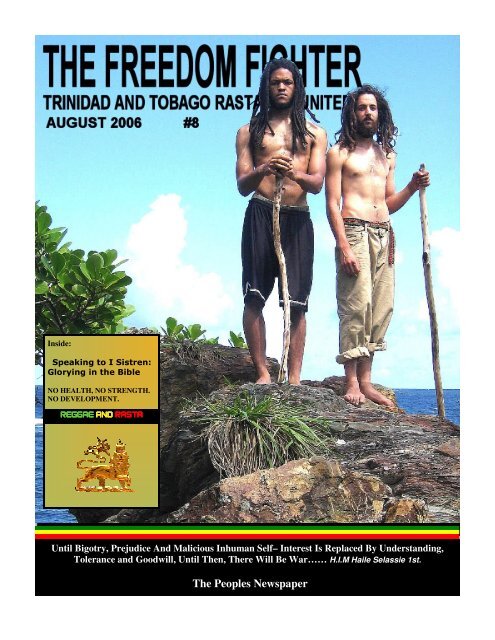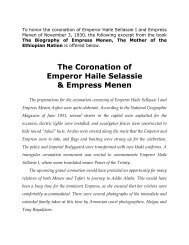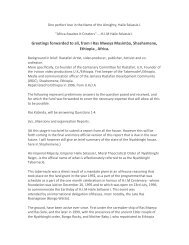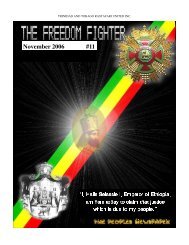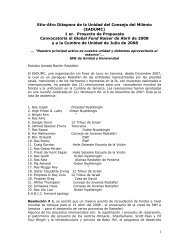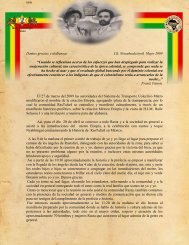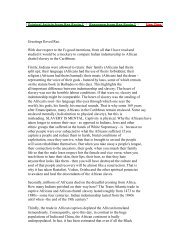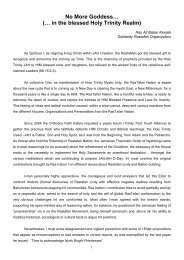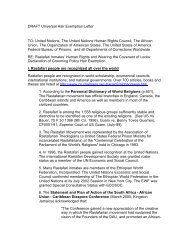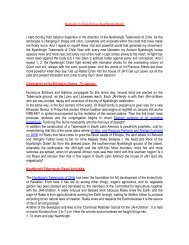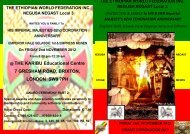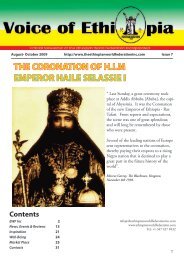Create successful ePaper yourself
Turn your PDF publications into a flip-book with our unique Google optimized e-Paper software.
Inside:<br />
<br />
<br />
NO HEALTH, NO STRENGTH.<br />
NO DEVELOPMENT.<br />
<br />
<br />
<br />
Until Bigotry, Prejudice And Malicious Inhuman Self– Interest Is Replaced By Understanding,<br />
Tolerance and Goodwill, Until Then, There Will Be War…… H.I.M Haile Selassie 1st.<br />
The Peoples Newspaper
TRINIDAD AND TOBAGO RASTAFARI UNITED INC.<br />
Cover Art— Ras Ravin-I<br />
Cover Photo—<br />
Ras Kwame Briggs<br />
Design and layout—<br />
Ras Ravin-I<br />
Writers—<br />
Ras Jahaziel /<br />
Empress Gong / Dr. Lance<br />
Seunarine/ Ram Ehrlic<br />
Edited By-<br />
Ras Ravin-I<br />
Ras Jahaziel<br />
Photographs—<br />
Ras Kwame<br />
Art Work<br />
Ras Ravin– I<br />
Ras Jahaziel<br />
H.I.M Photos—<br />
TTRU Rastafari Archives/<br />
All artwork are copyrighted,<br />
and is the property of<br />
Ras Jahaziel and Ras Ravin-I<br />
Duplication or copying is<br />
strictly prohibited<br />
© 2005<br />
IN THIS ISSUE :<br />
Page 2— Ads / Credits<br />
Page 3— Rastafari Speaks<br />
Page 4— No Health, No Development<br />
Page 5— No Health , No Development<br />
Page 6— Omega Frontline /<br />
Page 7— Omega Frontline /<br />
Page 8— Omega Frontline /<br />
Page 9— Rasta and Reggae<br />
Page 10— Rasta and Reggae<br />
Page 11— Rasta and Reggae<br />
Page 12— The Black People of India<br />
Page 13– Ras Jahaziel—The Revelator<br />
Page 14– Nyahbinghi Creed<br />
Page 15– Pic<br />
Page 16— People in the Spotlight<br />
FROM THE “ROARING 70’S BY<br />
ZENO OBI CONSTANCE:<br />
A new force was emerging among the grassroots<br />
of Trinidad and Tobago. From the poverty<br />
stricken hills of<br />
Lavantille to the folk centered<br />
communities of Cedros and<br />
Charlotteville came the rhythms of<br />
Reggae and the rise of Rastafari.<br />
Many of the brothers and sisters who had been<br />
influenced by the events of the early and mid<br />
seventies were now the sons and<br />
daughters of Jah Rastafari.<br />
“Learning and profound knowledge nurture noble<br />
character and impart wisdom. The family unit and<br />
educational establishments have great responsibilities<br />
in these endeavors for they are the basis of national<br />
progress and prosperity”.<br />
His Imperial Majesty speaks on<br />
“THE VALUE OF EDUCATION”<br />
<strong>August</strong> 2006 The Freedom Fighter. Pg 2
TRINIDAD AND TOBAGO RASTAFARI UNITED INC.<br />
Speech to University of West Indies<br />
"Vice-Chairman and Distinguished Guests. I feel deeply honored<br />
this afternoon for the fact that the University of the West<br />
Indies has conferred upon me the degree of Doctor of Laws<br />
Honoris Causa.<br />
"The history of the Ethiopian people is long, and in this history<br />
which became Christian the earliest, the early education of<br />
Ethiopians was based on Christian teachings and the Bible.<br />
“Although the university and the responsibility of the educators<br />
in the centuries past was slightly different from what we have at<br />
present, nevertheless the Christian Ethiopians have carried forward<br />
the idea of unity of our people. Our Christian forefathers<br />
have brought education and have expanded it in our country.<br />
These have become the basis and the explanation in part for the<br />
maintenance of independence by the Ethiopian people so many<br />
thousands of years.<br />
"At that time universities of their own nature and professors did<br />
exist, thus the learnings that were started in churches, learnings<br />
that were always dedicated upon the idea of GOD, spread in<br />
Ethiopia and this has helped to make Ethiopia free.<br />
"Although we are now quite proud of our Christian heritage we<br />
must also stress that Ethiopia is the modern state. That in Ethiopia<br />
there is religious tolerance. Religious tolerance has been<br />
practiced in Ethiopia for decades. This is precisely why the<br />
unity of our people has become time tested. This is partly why<br />
the Ethiopian people have defended themselves against foreign<br />
aggression.<br />
"But the times have changed and even the purpose of education<br />
has altered. It has become necessary for the Ethiopian people to<br />
turn their attention toward the establishment of modern educational<br />
institutions. At first we were not able to do this without<br />
help. It has become necessary for me to send students for studies<br />
to foreign countries. Secondly, even before the invasion we<br />
had commenced the important task of establishing primary and<br />
secondary schools in numbers for the millions of Ethiopians.<br />
Our efforts in this direction as is well known have been interrupted<br />
by aggression against our peaceful people.<br />
<strong>August</strong> 2006 The Freedom Fighter. Pg 3
TRINIDAD AND TOBAGO RASTAFARI UNITED INC.<br />
NO HEALTH, NO STRENGTH. NO DEVELOPMENT.<br />
By Dr Lance Seunarine<br />
I want to thank the Rastafari Corporation, the<br />
Boboshanti, and the Binghi House of Siparia, Ras<br />
Ravin, Ras Jag and the Trinidad and Tobago Rastafari<br />
United (TTRU) for making this gathering a success. Before<br />
I continue with my presentation, I want to thank<br />
my brother Terry for flying in to help us with the health<br />
Clinic; I want to thank my niece for assisting in the distribution<br />
of free reading glasses. I want to thank my<br />
daughter Imani for also making this trip to assist in the<br />
presentation on Domestic Violence. I want to thank my<br />
wife Gladys and the Bridal Cottage for donating several<br />
pairs of glasses to the eye glasses program. I want to<br />
thank Sister Ichel and her daughters for demonstrating<br />
how we can remain physically fit at all times. For the<br />
American contingent, I want to say in Kiswahili Asante<br />
Sana . For all those who forwarded to make this a success,<br />
Misgana -- Thank you.<br />
This lecture is important to me for today two months<br />
ago, I lost my friend, no my brother to Diabetes and the<br />
carelessness of the staff at the San Fernando General<br />
Hospital . What was to be a simple changing of bandage,<br />
turned out to be fatal to my friend and brother<br />
Max Ferguson. Fergie left a mentally challenged son<br />
named Carlos and a seventeen year old name Brian. I<br />
want you all here to know that Brian has stepped up to<br />
be the father of Carlos. He is my Man-child. INI and<br />
my brother Ken serve as surrogate fathers me, long distance<br />
from America, and my brother Ken who lives in<br />
Point Fortin. My wife Gladys also serves as his surrogate<br />
mother.<br />
world wide. It is responsible for approximately 1 million<br />
deaths per year. One dose of quinine cost 55 cents; it<br />
costs $1 for a mosquito net; it costs $5.95 to spray a mosquito<br />
net with a life span of 5 years; it costs $10 per<br />
household to coordinate inside spraying annually. A death<br />
sentence has been pronounced on 1.8 million Ugandans.<br />
The equivalent amount of nets has been approved by<br />
Global fund and it has not arrived due to government mismanagement.<br />
According to Celia Dugger a NYT reporter,<br />
The US AID Agency earmarked 1% of the<br />
agencies budget for medicine; 1% for insecticides, and<br />
6% for nets. In other words, 92% went for research, and<br />
administrative costs. We know that DDT SPRAYED IN<br />
STAGNANT WATER CONTROLS THE SPREAD OF<br />
Malaria. This can be easily accomplished by hiring local<br />
people to spray and distribute the nets. The fight against<br />
Malaria cannot be won unless Rastafari become intricately<br />
involved in this drive for total eradication. The<br />
fight must have a strong commitment from Rastafari, for<br />
we are the most likely group that will repatriate to Africa .<br />
For the Mother land, the cost impact from Malaria is<br />
enormous. Emperor Selassie I informed us in 1958 that<br />
Malaria could be contained for $58 million; today, the<br />
cost has skyrocketed to $12 billion annually; In Swaziland<br />
and South Africa , both have been successful in curtailing<br />
its spread where the death toll is now 5 per 1000<br />
compared to 66 per 1000 in 1999. So in 7 years, there has<br />
been a drastic improvement. In 1980 in southern and eastern<br />
Africa , 1 in 5 children under 5 years died due to this<br />
disease; in 1990 the ratio was 1 in 3.<br />
Selassie I, Our father has often said that without health<br />
there can be no education and no economic development.<br />
So today, I want to address some of the conditions<br />
that presently exist in Africa . In Africa , 20,000<br />
die per day (NYT 2/27/05); Malaria kills 2,000 people a<br />
day. It requires $ 6 billion to eradicate this disease<br />
<strong>August</strong> 2006 The Freedom Fighter. Pg 4
TRINIDAD AND TOBAGO RASTAFARI UNITED INC.<br />
NO HEALTH, NO STRENGTH. NO DEVELOPMENT.<br />
By Dr Lance Seunarine<br />
In Mozambique :<br />
· 40% of its malaria infected patients were out patients<br />
· The impact on Malaria in Mozambique is costly to its<br />
GNP-- it is scaring away tourist.<br />
· free nets are given out<br />
· House to house spraying of DDT is undertaken<br />
throughout the country.<br />
· A joint venture between British, Australian and local<br />
business equal $2.6 million to eradicate Malaria.<br />
Here is another killer!<br />
According to Dr. Silinick President Elect of the Diabetes<br />
Federation, Diabetes kills 230 million people world wide<br />
with China leading with 39 million in the age sets 20 and<br />
over; India has 30 million infected or approximately 6%<br />
of its population. In America , over 250,000 die per year.<br />
In the Caribbean , it is estimated that 12% -20% of its<br />
population suffers from Diabetes. While Type Two affects<br />
predominantly older people, studies have shown that<br />
it affecting younger people. In Trinidad , there are cases<br />
reported as young as 11 years. It is a silent killer that can<br />
be with you for over twenty years before it is discovered.<br />
Diabetes attacks your kidneys, your liver and can cause<br />
blindness. I had TWO uncles who became blind and who<br />
eventually die from this disease. The US government believes<br />
that by 2026 there would be 350 million people<br />
suffering from diabetes. Death toll is expected to increase<br />
by 25% in the next decade. In some countries like Mozambique<br />
, the cost of insulin infections are astronomical<br />
where people are walking death/ zombies knowing quite<br />
well that in one year they will die. In Mali , it is estimated<br />
that they will live up to 30 month before dying. While<br />
Type I Diabetes is genetic, Type two can be controlled by<br />
exercising and eating properly. Diabetes is controllable by<br />
the way you control your obesity. Now mark you, I am<br />
not telling you to become a Twiggy or a Cindy Laupin;<br />
but you must exercise, Maybe we can have Sister Ichel<br />
and the Watotos teach you some fundamentals so that you<br />
can stay fit and well armed until her next visit; you must<br />
reduce your salt intake, stay away from trans fat (Pizza<br />
Hut and Kentucky Fried chicken are two prime examples)<br />
and eat Roti with Channah and not eat pigs feet and<br />
souce. Now we all know that Rastas don’t eat meat, but<br />
there are some of us here who do eat meat. If you eat<br />
well, and exercise, you can live to a ripe old age. Especially<br />
of you buy the food from Ras Shawn.<br />
Finally, my idrens I would be loathe if I did not speak<br />
about Darfur and the atrocities that have been taking<br />
place there. There has been a mass exodus of over 2<br />
million of its people to the neighboring countries. The<br />
death toll is estimated at 160,000 to 450,000 and the<br />
janjaweed or the Sudanese Liberation front should be<br />
held responsible; we, too, must share the blame for we<br />
have remain silent as Africans murder Africans. We<br />
must speak out against this atrocity that is killing and<br />
maiming our brothers and sisters. We cannot have another<br />
Rwanda “Never Again.<br />
Give thanks, Blessing and Irie<br />
Brother Lance Seunarine.<br />
50th Anniversary Of His Imperial<br />
Majesty Emperor Haile Selassie:<br />
First Visit To The United States<br />
1954-2004<br />
by Ras Nathaniel<br />
# Paperback: 148 pages<br />
# ISBN: 1412037026<br />
<strong>August</strong> 2006 The Freedom Fighter. Pg 5
TRINIDAD AND TOBAGO RASTAFARI UNITED INC.<br />
<br />
<br />
<br />
<br />
<br />
<br />
<br />
• ! "<br />
<br />
<br />
<br />
<br />
<br />
<br />
!" # <br />
$% <br />
<br />
& <br />
' ( $ % )<br />
& * +<br />
, &<br />
' - &. & <br />
* ( <br />
(&( " /"<br />
" "&* 0 <br />
&( +"" & '<br />
" *<br />
* + <br />
" *+"" & <br />
. &<br />
, * # <br />
( (& * <br />
" $ ' '<br />
# % " <br />
( * ( <br />
( <br />
*<br />
& ( ( ( <br />
*(<br />
' <br />
1 1 (( &<br />
&*( &<br />
, <br />
& &*2 <br />
' &- .<br />
(<br />
"* ( "<br />
" * <br />
& <br />
<br />
' <br />
* " (<br />
' " & & & <br />
*<br />
<br />
& "* # <br />
( . + <br />
( .* ("0'<br />
'&(" ."&*<br />
& " (<br />
* " <br />
+ ( '<br />
( -!0*. 3 45 <br />
-. <br />
* <br />
' & <br />
"" <br />
6 ' 7*<br />
<br />
('(( ( <br />
" 2( ** <br />
8 &( ( <br />
" ' " *( <br />
"9!!<br />
* : & " (<br />
&" '1 ( &(<br />
( &* <br />
$ % " 3<br />
( ** '<br />
*<br />
<strong>August</strong> 2006 The Freedom Fighter. Pg 6
TRINIDAD AND TOBAGO RASTAFARI UNITED INC.<br />
<br />
<br />
# <br />
<br />
# <br />
<br />
$%! <br />
& <br />
'<br />
• ! "<br />
<br />
;( 1 <br />
*( *<br />
:'-. <br />
& '" (<br />
"* <br />
" , " " <br />
' <br />
= *: <br />
9* ' 9 9('<br />
: + ;0 ?( $<br />
(% <br />
*&(( ("<br />
+ +0 ( <br />
( <br />
*<br />
<br />
"'<br />
" $=?%* : <br />
(
TRINIDAD AND TOBAGO RASTAFARI UNITED INC.<br />
• # :<br />
"(44648446BF446E<br />
@64C458@6@A@IF@6@E<br />
) 46CG<br />
<br />
• : =;!2 # 2399 ; : :)9<br />
#!:J;<br />
+ B64E4C8 B6@B8 I6@A8 E6G448<br />
E64I84H6IGHAF4H6HI<br />
+ H64FE64E<br />
G6I8G6EF4I64C45<br />
* (E6BB<br />
<br />
• + :;! 3 K ;
TRINIDAD AND TOBAGO RASTAFARI UNITED INC.<br />
<br />
<br />
By Ram Ehrlich.<br />
This is the first in a series of articles on the subject<br />
of reggae music. This month we begin to look at the<br />
connection between reggae music and Rastafari, and<br />
why the man in the street might think they’re the<br />
same thing.<br />
In the world outside the Caribbean, it seems that reggae<br />
music and Rastafari faith are often seen as identical,<br />
or that reggae is a part of/ product of Rastafari culture.<br />
While there is a deep and complex connection between<br />
these cultural streams, the oversimplified idea that they<br />
are the same is a misconception.<br />
No doubt, the likely source of the confusion is Bob<br />
Marley’s international fame. Other artists, like Desmond<br />
Dekker, Jimmy Cliff and Prince Buster paved the<br />
way in the sixties for reggae's emergence and acceptance<br />
worldwide. But none of them could quite match<br />
Bob Marley's charisma and the impact of his 1973 debut<br />
on the world stage -- nor did any of them fully project<br />
the image or culture of Rastafari. Notice however,<br />
that the title of the first international reggae hit (#7 on<br />
the US Top 40) in 1969 by Desmond Dekker is "Poor<br />
Me Israelites".<br />
Bob Marley had been turned to the faith by the elder<br />
Mortimer Planno, who saw in Bob (already a rudeboy<br />
star in the Caribbean and England as one of the Wailers)<br />
the perfect vehicle for spreading the message of<br />
Rastafari across the world through music. Planno,<br />
among others, prepared him accordingly. And they<br />
weren't wrong -- Marley quickly surpassed all of his expectations,<br />
becoming an international icon and an ambassador<br />
for reggae music, the Rastafari faith, Jamaica,<br />
African freedom struggles, ———><br />
even the herb. Marley’s image was so powerful that he<br />
eclipsed all the other Jamaican artists emerging internationally<br />
around the same time, including successful former<br />
band mates Peter Tosh and Bunny Wailer. So powerful<br />
in fact that when Bob passed on in 1981, the world<br />
said "reggae is dead."<br />
Reggae of course was not dead, but no roots artists including<br />
Burning Spear, Dennis Brown, Black Uhuru or<br />
Gregory Isaacs (all Rastas) seemed able to fill the void on<br />
their own, at least on the foreign market. Very quickly,<br />
world interest in reggae and distribution of the records<br />
declined. Unfortunately, the end result is that the average<br />
person outside of the Caribbean probably can’t name<br />
many other reggae artists besides Bob.<br />
In the years just before Marley passed, due to the outside<br />
pull of his worldwide popularity, many reggae artists<br />
longed to "crossover" and tried hard to follow in his footsteps.<br />
Foreign record companies, especially Island/<br />
Mango and Virgin willingly obliged. The companies<br />
would send talent scouts on expensive junkets to Kingston<br />
to sign up artists, hoping to duplicate or cash in on<br />
Bob's success. There was a pressure to “be Rasta”. It<br />
was even said at the time that if you didn't have dreadlocks<br />
you couldn't get a record contract. Many artists desperate<br />
for success climbed on the bandwagon, adopting<br />
the Rasta image and content for their music.<br />
For many true Rasta artists, their time had simply come:<br />
by 1976, for older and deeper historical reasons, Rastafari<br />
was stepping to the forefront of Jamaican mindset, and<br />
was definitely projecting itself through the broader culture<br />
of reggae music, though probably this strong shift towards<br />
Rasta would have occurred eventually, even without a<br />
music scene. Since the fifties, local music had always<br />
been a strong cultural forum and daily newspaper for the<br />
society (as in Trinidad and elsewhere.)<br />
BY RAS JAHAZIEL<br />
FOR MORE INFO VISIT<br />
www.rastafarivisions.com<br />
OR CONTACT RAS JAHAZIEL @<br />
919-244-5808 in Garner, NC.<br />
<strong>August</strong> 2006 The Freedom Fighter. Pg 9
TRINIDAD AND TOBAGO RASTAFARI UNITED INC.<br />
<br />
<br />
Sadly, just as Rasta dominance over Jamaican consciousness<br />
was reaching heights, it would all quickly<br />
go down by the 1980 election in a hail of violent reactionary<br />
gang warfare, imported bullets and cocaine<br />
smoke, all due to worse than usual polytricks and poverty.<br />
Marley’s death in May of the following year<br />
blighted the music scene even more. Even though Jamaican<br />
music of the eighties seemed to turn away from<br />
spiritual themes and take on a colder, more gangster<br />
lean towards slackness, the Rasta image of reggae<br />
still remained firmly in place on the foreign market.<br />
Despite these declines during the post-Marley period,<br />
reggae would continue to affect music around the<br />
world, eventually taking its place as a Grammy category<br />
beside blues, rock, R&B, jazz, Latin and other<br />
mainstream genres as an established and respected<br />
form of music. Not until the early 1990s, after morphing<br />
from reggae to dancehall around 1985, would Jamaican<br />
music fully regain its strong worldwide popularity<br />
and position of influence. Newer sounds and<br />
different ambassadors have emerged: Sizzla, Capleton,<br />
Sean Paul, Shabba, Buju, Shaggy etc.<br />
Today, if the sales statistics are any indication, it's as if<br />
Bob never departed: his album "Legend" has held a<br />
permanent place on the Billboard Top 100 Albums<br />
chart since its release. Growing sales of his other records<br />
and Marley merchandise far outstrip Bob’s financial<br />
achievements during his own lifetime. And<br />
thanks to studio technology, Marley is still on the<br />
scene, singing duets with artists who weren’t even<br />
born yet when he passed on.<br />
We have seen some the reasons why it was and still is<br />
easy for those outside the Caribbean to mistake reggae<br />
and Rastafari as being identical. Questions remain:<br />
what is the fuller story on reggae music and what is<br />
Rasta music? How did Rasta faith and Jamaican<br />
music overlap as they evolved? What led to the high<br />
position of reggae music and Rasta thought in late<br />
seventies Jamaica? ? A great deal of mostly accurate<br />
material has been written on these subjects, so we will<br />
not attempt to do it all here. Next we’ll start to trace<br />
these cultural cross-currents in more detail.<br />
Greetings once again:<br />
This is the second in a<br />
regular series of articles<br />
about reggae music. Last<br />
time we dealt with dispelling<br />
certain myths surrounding<br />
reggae music and<br />
its connections to Rastafari.<br />
We highlighted the<br />
misconception (outside the<br />
Caribbean) that reggae music is pure Rasta music or entirely<br />
the product of Rastafari culture, and attempted to explain<br />
how this misconception came about.<br />
The history of Jamaican popular music’s development<br />
shows that, at every stage and from the beginning, Rasta<br />
culture has always made significant contributions, but that<br />
the music was developed by all sorts of people and cultural<br />
influences, both Jamaican and foreign, which had nothing<br />
to do with Rastafari. At the end of our last installment, we<br />
posed the question, among others, “what is the fuller story<br />
on reggae music and what is Rasta music?” Unfortunately,<br />
due to space limitations this month, we’ll only be able to<br />
scratch the surface of this topic, to be continued next<br />
month.<br />
To address these questions, it is first necessary to set the<br />
stage by exploring the nature of Caribbean culture in general.<br />
Caribbean culture is the result of different cultures,<br />
most of them imported (mostly by force) and not indigenous<br />
to the area, mixing together in a wildly complicated<br />
process of cross-fertilization. It can be thought of as a<br />
complex fabric and, like fabric, the result of multiple<br />
strands of cultural traditions cross-woven into a greater<br />
whole. In the same way, each Caribbean island tends to<br />
have its own distinctive culture which is also the result of<br />
different ethnic traditions weaving themselves together<br />
into a new hybrid fabric over time. This phenomenon occurs<br />
on multiple levels: language, race, music, cuisine, agricultural<br />
methods, architecture, etc.<br />
To address these questions, it is first necessary to set the<br />
stage by exploring the nature of Caribbean culture in general.<br />
Caribbean culture is the result of different cultures,<br />
most of them imported (mostly by force) and not indigenous<br />
to the area, mixing together in a wildly complicated<br />
process of<br />
<strong>August</strong> 2006 The Freedom Fighter. Pg 10
cross-fertilization. It can be thought of as a complex fabric<br />
and, like fabric, the result of multiple strands of cultural<br />
traditions cross-woven into a greater whole. In the<br />
same way, each Caribbean island tends to have its own<br />
distinctive culture which is also the result of different ethnic<br />
traditions. Trying to disentangle and trace back all<br />
these cultural threads continues to be the subject of much<br />
painstaking research. The informants who perhaps could<br />
have easily solved these mysteries, had anyone bothered<br />
to ask them at the time, have been dead for hundreds of<br />
years, and the threads themselves have changed a great<br />
deal by being interconnected and influencing each other<br />
over centuries, a process that is ongoing today. Added to<br />
this, is the nature of smaller island cultures, where information<br />
and cultural trends tend to spread quickly and undergo<br />
a high degree of recycling. Just as it seems an older<br />
tradition has nearly died out, it springs back to life in a<br />
new form, usually mixed with another newer tradition.<br />
This tendency has been observed and well documented<br />
not only in the Caribbean, but in other areas of the world<br />
like Indonesia, particularly the island of Bali.<br />
Thus, in the course of Caribbean cultural research, it<br />
seems that every answer unlocks twice as many questions<br />
or presents twice as many contradictions. There usually<br />
emerges a set of simplified, convenient theories which<br />
become the “official” and widely accepted explanations<br />
for what is going on culturally. While these “official versions”<br />
are usually “true” in essence, it usually turns out on<br />
closer inspection that they are only a fragment of a<br />
greater, more complicated truth.<br />
The origin of pure Rasta music and reggae music is no<br />
exception. For reggae music the “official” story usually<br />
reads: “Jamaicans listened to 50s R&B records broadcast<br />
on Miami radio stations, and in attempting to imitate it<br />
they turned the beat around, and presto, ska music was<br />
born, which turned into rock steady, which became reggae<br />
which was invented by Bob Marley.” Partially true,<br />
but skewed, simplistic and hardly the whole story.<br />
TRINIDAD AND TOBAGO RASTAFARI UNITED INC.<br />
<br />
<br />
<br />
<br />
<br />
! <br />
" # $ % & <br />
<br />
<br />
<br />
<strong>August</strong> 2006 The Freedom Fighter. Pg 11
TRINIDAD AND TOBAGO RASTAFARI UNITED INC.<br />
THE BLACK PEOPLE OF INDIA<br />
The boundaries of the ancient Ethiopian kingdom of<br />
Cush, stretched as far as India which was known as<br />
the Indus Kush and its people the Dravidians or Dalits<br />
are well defined and documented as Africans.<br />
Dr. Cheikh Anta Diop stated that:<br />
"There are two well-defined Black<br />
races: one has a black skin and woolly<br />
hair; the other also has black skin, often<br />
exceptionally black, with straight<br />
hair, aquiline nose, thin lips, and an<br />
acute cheekbone angle. We find a prototype<br />
of this race in India: the Dravidian.<br />
It is also known that certain Nubians<br />
likewise belong to the same Negro<br />
type...Thus, it is inexact, anti-scientific,<br />
to do anthropological research, encounter<br />
a Dravidian type, and then conclude<br />
that the Negro type is absent."<br />
The contributions to human development made by Africans<br />
and African descended peoples in India have<br />
been deliberately overlooked by European and Indo-<br />
European scholars, not that we need their approval to<br />
design and contribute to human growth. European<br />
greed designed and carried out horrendous atrocities<br />
from since the dawn of modern history. Their desire to<br />
control the economy of the world supersedes the desire<br />
to leave the Iration of Jah Rastafari as it was created.<br />
The Caucasians used the term Abyssinian or Negro in describing the people found in India<br />
for they resembled the Africans in their culture and custom.<br />
I-n-I have been the victims of subjective living and genocidal extermination by the Caucasians<br />
since the beginning of modern humanity. The African race consists of the Aborigines<br />
of Australia, New Guinea, Bangladesh and Eastern India, the Dravidians of India, Sri-<br />
Lanka, and all of the African continent and its Diaspora in the western hemisphere.<br />
Herodotus said, "There are two great Ethiopian nations, one in Sind (India) and the other in<br />
Egypt".<br />
<strong>August</strong> 2006 The Freedom Fighter. Pg 12
TRINIDAD AND TOBAGO RASTAFARI UNITED INC.<br />
Ras Jahaziel The Revelator<br />
Clarifying The Concept Of "Spirituality"<br />
What Is Rasta Spirituality?<br />
RAS JAHAZIEL<br />
As a people who have been THE WHITE MAN'S<br />
PROPERTY for so very long, we have grown accustomed<br />
to searching for "GOD" through other people's<br />
eyes. If it is not the white man's eyes, it has been the<br />
Arab's, the Chinese or the Indian's eyes. This idea that<br />
"spirituality" means soaking up the White man's, the<br />
Indian's, the Chinese or the Arab's ideas, is all part and<br />
parcel of our own degraded sense of self-hood.<br />
When we rediscover and resurrect an appreciation for<br />
ourselves as THAT UNIQUE PEOPLE OF CREA-<br />
TION WHO HAVE BEEN BLESSED WITH THE<br />
WOOLEN CROWN OF HAIR, we will find a greater<br />
link with the God that we have been seeking so vainly<br />
for so very long. It is only within our own image that<br />
we as a people will find our God. Never through any<br />
other people's eyes.<br />
Any people that view God through another people's<br />
eyes will always remain CULTURALLY SUBSERVI-<br />
ENT to that other people. Because culture and spirituality<br />
are not remote from each other, it means that such<br />
cultural subservience will entail spiritually crucifying<br />
OUR TRUE GOD-HEAD and preferring BARABBAS<br />
instead.<br />
Under the influence of such FOREIGN SPIRITUALI-<br />
TIES, we have often become ideologically divorced<br />
from our own unique history which in itself carries a<br />
certain HISTORICAL IMPERATIVE. It is this historical<br />
imperative which characterizes The Rastaman's<br />
brand of spirituality.<br />
Because of the influence of such history, DEVIL and<br />
GOD are demystified. HEAVEN and HELL are no<br />
longer HERE-AFTER and OUT 0F-WORLDLY, and<br />
THE AFRICAN HOLOCAUST is conceptualized as<br />
the Black man's main lesson book in the college of<br />
TRUE BLACK SPIRITUALITY. It is BLACK SPIRI-<br />
TUALITY without an apology, for it must be seated<br />
within a particular cultural and historical framework,<br />
distinguished from all that was picked up in the supermarket<br />
of intellectual consumerism.<br />
CHAPTER SIX FROM THE BOOK OF JAHAZIEL:<br />
MIND CONTROL ON THE PLANTATION<br />
In the same way that he trained animals by giving them<br />
TREATS when they obey, THE SLAVER trained his<br />
slaves in THE ART OF COMPROMISE, and the skill of<br />
HOW TO BOW AND BEND, and how to keep silent until<br />
the Slave Master tell you when. They were rewarded and<br />
given "PROMOTION" for faithfully obeying the Slaver's<br />
rules and not behaving "TOO BLACK," They were encouraged<br />
to go to Church and talk about heaven, BUT<br />
NEVER TALK ABOUT AFRICAN LIBERATION.<br />
MAINTAINING CONTROL OF STOLEN PROPERTY<br />
required that the Afrikan be made to believe that the white<br />
man is more civilized and he always knows best, so you<br />
can't go wrong when you quote him and let him do the<br />
thinking for you. Blacks internalized the belief and are still<br />
guided by it today, that DETERMINING WHAT IS<br />
WHAT is something best left to WHITE EXPERTS alone,<br />
and it is wiser not to have your own opinion, but wait and<br />
hear what the white man has to say ...because he always<br />
knows best. If he tells you that poison is good for you and<br />
labels it with some big words that you can't pronounce,<br />
then drink it down with confidence like if it is blessed by<br />
the lord. If he tells you that a certain medicine is bad, then<br />
hate it and scorn it, even if your people had been using it<br />
for centuries before coming to know the white man. This<br />
belief and trust in the white man's advice is what ran THE<br />
AFRICAN BUSH DOCTOR disastrously out of business.<br />
THE OWNERS encouraged their slaves to read the same<br />
book all the time, over and over again, and MEMORIZE it,<br />
and BELIEVE it, and UNDER-stand it the way the Teachers<br />
of White Christianity VISUALIZED IT, INTER-<br />
PRETED IT AND EXPLAINED IT TO THEM. White<br />
Christianity is making millions of dollars today by writing<br />
books which EXPLAIN the Bible but never any denouncing<br />
the years of RACIST THEOLOGY which have created<br />
black inferiority.<br />
Continued next month...<br />
<strong>August</strong> 2006 The Freedom Fighter. Pg 13
TRINIDAD AND TOBAGO RASTAFARI UNITED INC.<br />
NYAHBINGHI CREED<br />
Princes and Princesses must trod out of Egypt,<br />
Ithiopians now stretch forth their hands to Haile Selassie I, JAH Rastafari<br />
O'Haile Selassie I of Ithiopia, I an'I Ivine Majesty, Thy Irits come into I to<br />
dwell in the parts of righteousness.<br />
Lead I an'I, Help I an'I to forgive that I an'I must be forgiven<br />
Teach I an'I love, loyalty on earth as it is in Zion<br />
Endow I an'I with thy wise mind, knowledge and overstanding to do Thy<br />
will,<br />
Thy blessing to I an'I O JAH. Let the hungry be fed, the naked clothed,<br />
The sick nourished; the aged protected, and the infants cared for<br />
Deliver I an'I from the hands of I an'I enemies that I an'I must prove<br />
fruitful in these perilous days<br />
When Ian'I enemies are passed and decayed<br />
In the depths of the sea, in the depths of the earth or in the belly of a beast<br />
Give I an'I a place in thy Iverliving Kingdom<br />
Through the Power of the Kings of Kings, Lord of Lords,<br />
Conquering Lion of the Tribe of Judah, Elect of Himself and Light of This<br />
World,<br />
I an'I Ivine Majesty, Emperor Haile Selassie I, JAH Rastafari<br />
First I-ncient King of Iration<br />
JAH art the Alpha and the Omega, the Beginning Without End, the First<br />
and Forever,<br />
The Protectorate of all human faith and the Ruler of the Iniverse<br />
Thou art the only High Priest of the Order of Melchisedek,<br />
Who Liveth and Reigneth Foriver.<br />
I an'I hail to our JAH and King Emperor Haile Selassie I, JAH Rastafari<br />
! !!<br />
Almighty I, JAH Rastafari, Great and Thunderable I, JAH Tafari! !<br />
<strong>August</strong> 2006 The Freedom Fighter. Pg 14
T<br />
<br />
<br />
<br />
<br />
<br />
<br />
<strong>August</strong> 2006 The Freedom Fighter. Pg 15
TRINIDAD AND TOBAGO RASTAFARI UNITED INC.<br />
IN THE SPOTLIGHT<br />
Empress Ruth Auyhmahn Gabriel<br />
Empress Ruth Auyhmahn Gabriel, born Shaniqua Henley, was born on the beautiful island of<br />
Tortola in the tranquil British Virgin Islands. The only girl of three siblings, Empress Ruth was<br />
born to defend the cause of the Black race and humanity on a whole. She seeked to find the truth<br />
of who she truly was and what her purpose for life was. In the process of this soul seeking, she<br />
found her rest in Rastafari and her salvation in Quadamawi Haile Selassie the first. In 2004, she<br />
collaborated with Empress Sarai Ikembe Divinity to launch the V.I. Roots Dawtas “The Vizionary”.<br />
The vision of this newsletter is to uplift, promote and educate readers about Rastafari levity.<br />
This project is currently meeting its intended goals. In April of 2006, Empress Ruth welcomed the<br />
joy of her life into this world, Prince Ayinde Amdi Gabriel Vanterpool. Empress Ruth is an educator<br />
and uses her spiritual influence to encourage herself and others to meet their goals through<br />
the power of Haile Selassie the first.<br />
Empress Sarai Ikembe Divinity<br />
In 2004 she became Co-Iditor of a Rastafari Newsletter called “The Vizionary” which is published<br />
online every month and sold to brethren and sistren within the B.V.I. and other Caribbean<br />
Islands. A lady on a mission, she has let her light shine in many ways for all to see. Sista Sarai<br />
feels that she was placed on this Earth for a reason and a mission that she would fulfill to please<br />
the Most High. She has been an active member within the development of the Rastafari Community<br />
in Tortola and is very serious, committed, diligent and livicated when it comes to the<br />
work of Rastafari; and has taken a step forward and made an effort to bring about progress, inity<br />
and togetherness. She is currently enrolled in the H. Lavity Stoutt Community College where<br />
she is majoring in Teacher Education.<br />
Trinidad and Tobago Rastafari United, Inc.— P.O. Box 124, Port Ewen, NY 12466<br />
www.aiyamar.com - e-mail: fyzorasta@yahoo.com<br />
<strong>August</strong> 2006 The Freedom Fighter. Pg 16


